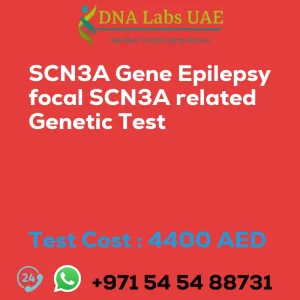VDAC1 Gene Encephalopathy Mitochondrial Genetic Test
Cost: 4400.0 AED
Test Components:
- Sample Condition: Blood or Extracted DNA or One drop Blood on FTA Card
- Report Delivery: 3 to 4 Weeks
- Method: NGS Technology
- Test Type: Neurological Disorders
- Doctor: Neurologist
- Test Department: Genetics
Pre Test Information:
Clinical History of Patient who is going for VDAC1 Gene Encephalopathy Mitochondrial NGS Genetic DNA Test
A Genetic Counselling session to draw a pedigree chart of family members affected with VDAC1 Gene Encephalopathy Mitochondrial
Test Details:
The Encephalopathy Mitochondrial NGS Genetic Test is a genetic test that is used to identify mutations in the VDAC1 gene. This gene is responsible for encoding a protein that is found in the mitochondrial outer membrane. Mutations in this gene have been linked to a variety of mitochondrial diseases, including encephalopathy.
Encephalopathy is a condition that affects the brain and can cause a range of symptoms, including seizures, cognitive impairment, and developmental delays. Mitochondrial diseases are caused by mutations in the genes that are responsible for the production of energy in the body. These mutations can lead to a range of symptoms, including muscle weakness, vision and hearing problems, and developmental delays.
NGS (Next Generation Sequencing) is a technique that is used to sequence the DNA of an individual. This technique allows for the identification of mutations in genes that are associated with various diseases, including mitochondrial diseases. The Encephalopathy Mitochondrial NGS Genetic Test uses this technique to identify mutations in the VDAC1 gene that may be responsible for the development of encephalopathy.
Overall, the Encephalopathy Mitochondrial NGS Genetic Test is a useful tool for the diagnosis and management of mitochondrial diseases, including encephalopathy. It can help identify the specific mutations that are responsible for the disease, which can inform treatment decisions and help improve outcomes for patients.
| Test Name | VDAC1 Gene Encephalopathy mitochondrial Genetic Test |
|---|---|
| Components | |
| Price | 4400.0 AED |
| Sample Condition | Blood or Extracted DNA or One drop Blood on FTA Card o |
| Report Delivery | 3 to 4 Weeks |
| Method | NGS Technology |
| Test type | Neurological Disorders |
| Doctor | Neurologist |
| Test Department: | Genetics |
| Pre Test Information | Clinical History of Patient who is going for VDAC1 Gene Encephalopathy mitochondrial NGS Genetic DNA Test A Genetic Counselling session to draw a pedigree chart of family members affected with VDAC1 Gene Encephalopathy mitochondrial |
| Test Details |
Encephalopathy mitochondrial NGS Genetic Test is a genetic test that is used to identify mutations in the VDAC1 gene. This gene is responsible for encoding a protein that is found in the mitochondrial outer membrane. Mutations in this gene have been linked to a variety of mitochondrial diseases, including encephalopathy. Encephalopathy is a condition that affects the brain and can cause a range of symptoms, including seizures, cognitive impairment, and developmental delays. Mitochondrial diseases are caused by mutations in the genes that are responsible for the production of energy in the body. These mutations can lead to a range of symptoms, including muscle weakness, vision and hearing problems, and developmental delays. NGS (Next Generation Sequencing) is a technique that is used to sequence the DNA of an individual. This technique allows for the identification of mutations in genes that are associated with various diseases, including mitochondrial diseases. The Encephalopathy mitochondrial NGS Genetic Test uses this technique to identify mutations in the VDAC1 gene that may be responsible for the development of encephalopathy. Overall, the Encephalopathy mitochondrial NGS Genetic Test is a useful tool for the diagnosis and management of mitochondrial diseases, including encephalopathy. It can help identify the specific mutations that are responsible for the disease, which can inform treatment decisions and help improve outcomes for patients. |








